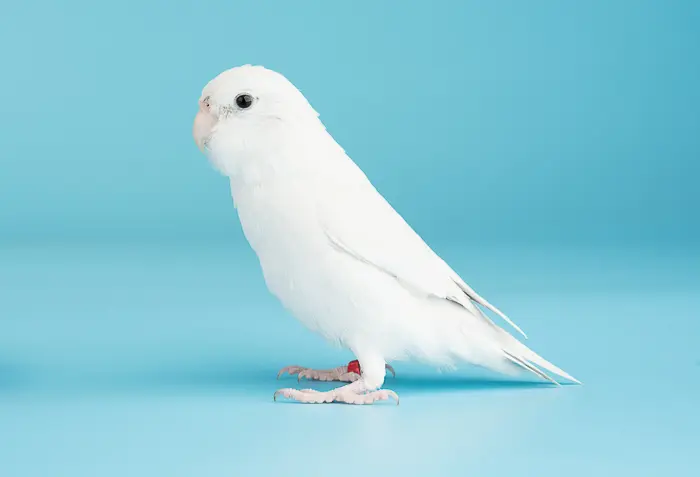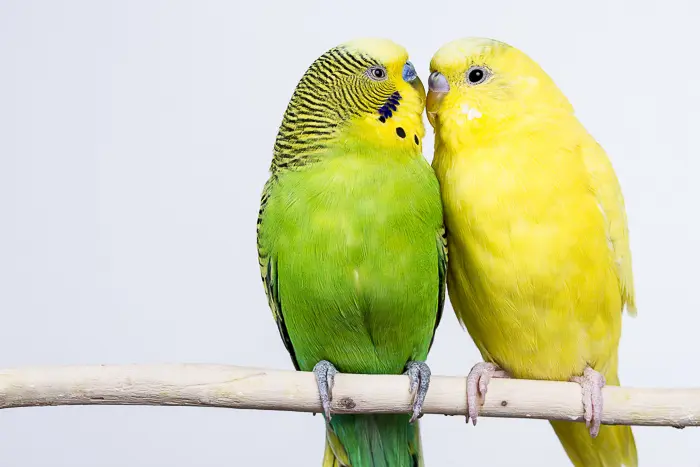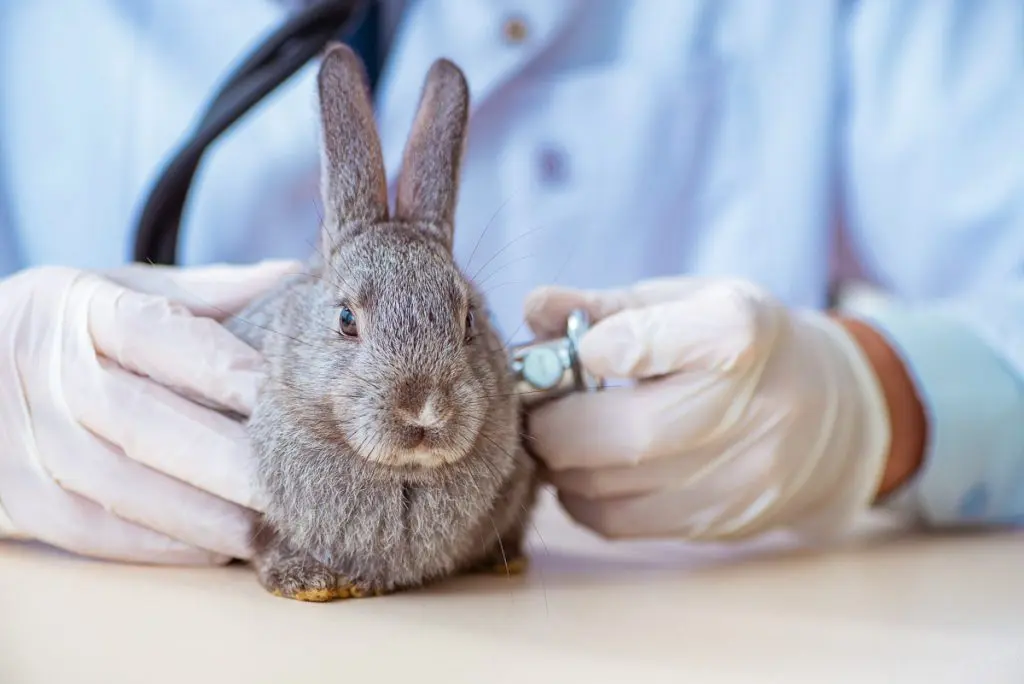They say birds of a feather flock together, but what about birds of different feather colors? Parakeets are one of the most popular types of pet birds and are available in many vibrant beautiful colors. Then there are parakeets that look distinctly different from the rest of the flock – so what's the difference between an albino parakeet (or budgie) and a Lutino budgie?
Dr. Jess explains the difference below:

What is a Parakeet or Budgie?
Parakeets, are also known as Budgerigars, or “budgies”, and are small members of the parrot family of birds.
They are herbivores (plant-eaters), can grow to about 7-8 inches in length, and can weigh up to as an adult.
They can commonly live to 10 years plus in captivity with the proper care and health maintenance routines performed by your local veterinarian.
They are seen in a bunch of bright bold colors, ranging from greens, blues, yellows, whites, and purples being the most common hues.
Most parakeets are smart and easily trained to listen to commands of those that they trust.
Most are friendly and like companionship and interaction with their owners – handling these birds daily makes most of them very happy!
Why Do Parakeets Come in So Many Different Colors?
The majority of parakeets have green, yellow, blue, purple, white, and orange markings.
The main reasoning between the difference is a lesson in genetics!
Just like human hair color – hair color and feather color depend on your maternal and paternal lines.
Let me explain in a little more detail below…

Parakeet Color Genetics:
There are two main types of pet parakeets: there is a green series and there is a blue series.
Green series budgies have a yellow base color, so that means that all of their feathers have yellow coloring to them.
This type of parakeet (green series) also has blue coloring on their body feathers, which combines with the yellow to make their heads typically yellow in color and their bodies green.
The blue series parakeets have a white base color with blue in the body feathers that makes their heads white and their bodies blue.
Ino Gene:
Lets dive a little further into parakeet genetics, shall we?!? It'll be fun!
The Ino gene is the name of the gene that is responsible for some color changes to a few different varieties of parakeets.
Because the the albino and the Lutino parakeet are made due to the Ino gene, they are often referred to as “Inos”.
This gene basically erases the blue coloring in the blue series (making them appear white to the naked eye) and the blue coloring in the green series parakeets (making them look vanilla or yellow to the naked eye) and all markings in or on their feathers.
This Ino budgerigar genetic mutation is also responsible for removing any eye or skin coloring in these albino and lutino budgies.
Both Lutino and albino parakeets have this Ino gene and it is associated with their color differences.
Both genetic variations, albino and lutino parakeets have pink or red eyes with a white ring around the iris (part of the eye you can see from the outside world), light-to-bright orange beaks, and light pink skin.
So… the summarize this genetics lesson….the Ino gene removes all the blue color, so all the blue series budgies become white and all the green series parakeets become yellow.
Albino is the term for a white Inos, Lutino is the term for a yellow Ino.
Ino Feather Color Breakdown:
Lutino budgies are of the green series parakeets with the ino gene incorporated.
This means that they have a yellow base color, where the ino gene removes their blue coloring and markings.
Therefore, lutinos are solid yellow with no markings, similar to a canary's solid yellow coloring.
A gorgeous bird if you ask me!
Albino budgies are of the blue series of parakeets who have the ino gene.
They have a white base color, and the ino gene takes out their blue coloring and markings.
This leaves albino parakeets with solid white feathering and no markings.
They are incredibly beautiful in person!
What is an Albino Parakeet?
The word “albino” creates the image in many of us of a white animal with red or pink eyes, and pink skin.
With parakeets, albinism is expressed as one would expect with other animals.
The parakeet's entire feathering is white, they have pink legs and a pink or brown cere, and the eyes appear pink or red.
Albino parakeets have all white feathers, red eyes and pink legs.
The Ino gene that this variety of parakeet has, causes all dark pigmentation to be removed from the skin, resulting in an all-white bird without dark coloration or pigmentation.

What is a Lutino Budgie?
Albino budgies are not the only budgies affected by the Ino gene.
A lutino budgie is a green series variety parakeet masked by the Ino gene mutation.
The budgie has a deep yellow body, as it should have been a green budgie, but thanks to the gene, it's a beautiful yellow.
Lutino budgie legs and cere are pink or brownish, and the bird has pink or red eyes.
Albino vs Lutino Budgies:
A lot of people confuse lutino and albino parakeets, but there are some major, major differences between the two varieties.
Both of these parakeets do have the ino gene, the lutino budgie is entirely yellow, where the albino is all white in color.
So the easiest way to tell the difference between these to varieties of budgies is to take a close look at their feather color.
Male or Female Albino Parakeet?
Many male budgies have a blue cere, the nose band that contains the nostrils, but males can also have pink ceres.
Female albinos and lutinos have the brownish-colored cere of typical female parakeets.
Are Albino and Lutino Budgies rare?
The albino and the lutino parakeet are fairly rare varieties of parakeets.
These budgies can be found for purchase, although many times are seen with a higher purchase cost because of their rarity.
Caring For an Albino or Lutino Budgie:
Caring for an albino or lutino budgie is no different from any other variety of budgie.
While they may look quite different from the rest of their counterparts, they aren’t any more vulnerable to any diseases or conditions.
They also do not have skin or vision problems associated with albinism like in other species of animals.
Make sure to care for your parakeet just like you would any other parakeet.
Good parakeet pet care includes:
- Proper hygiene
- High-quality nutrition
- Fresh, clean water
- Adequate housing
- Opportunities to socialize and exercise
- Proper Sleeping Environment
Summary:
The beauty of albino and lutino budgies can be jaw-dropping and the genetics behind their color differences can be brain-twistingly confusing.
Knowing exactly what the difference is between albino and lutino parakeets can help dampen the confusion that the Ino gene mutation brings out and the perplexity in their genetic differences going on behind the scenes of their feathers!

![[Vet Explains Pets]](https://vetexplainspets.com/wp-content/uploads/2024/09/cropped-vetlogo-199x66.png)


